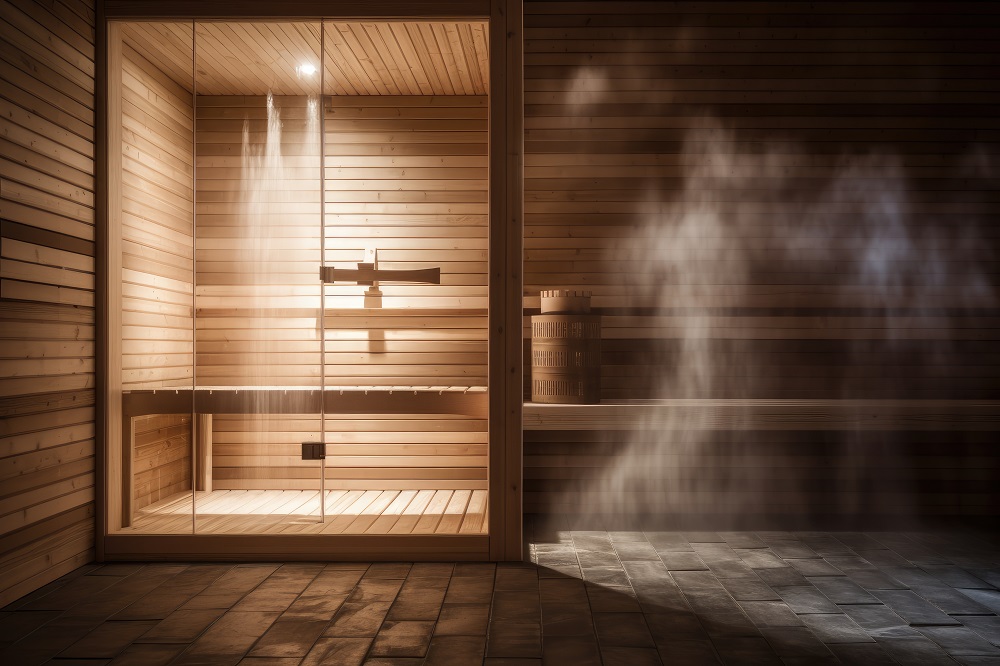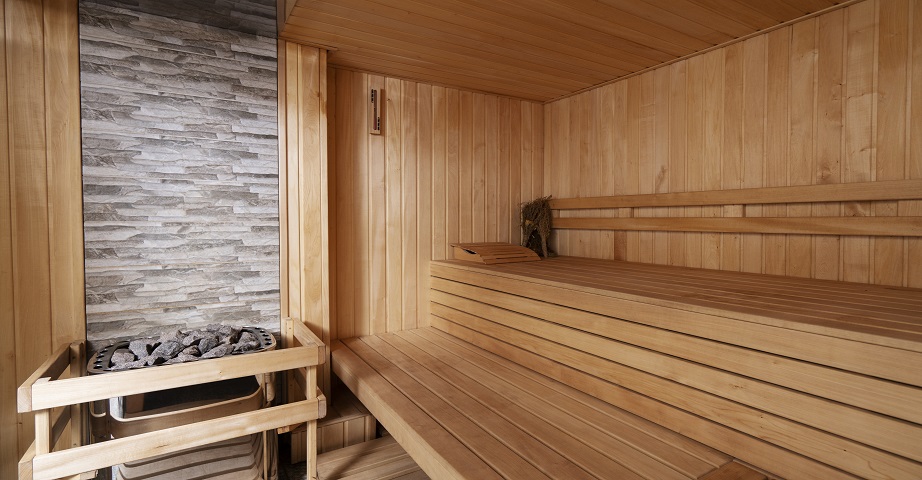What does sauna give? - The effect of sauna on the human body

Sauna is a method of body heating used for hundreds of years, which is currently an extraordinary form of relaxation. It is an inseparable element of Finnish culture, which is now known and used all over the world. Sauning is a short-term stay in a room where there are specific weather conditions - high temperature and high or low humidity. There are several types of saunas that can have a health-promoting effect on the human body. What are the benefits of a sauna? How to use it and what impact can a sauna have on sports achievements?
What is a sauna?
Sauna is a small room in which there is a high temperature — air is usually heated to 70-100 degrees Celsius, and depending on the type of sauna, high or low air humidity. Sauning lasts from a few to several minutes and is one of the most popular treatments using human body heating. It is a type of exposure that induces mild hyperthermia and thus can induce a thermoregulatory response of synergistically acting systems aimed at maintaining homeostasis of the body.
The history of the sauna is quite a complicated issue, and the first archaeological finds associated with it come from central Asia and are dated to VII century BC. Scientific data suggest that at that time the sauna served primarily as a shelter from frost and allowed the survival of severe winters.
In Europe, the sauna is associated primarily with Finland, where the sauna culture reaches about 2 thousand years, and the sauna is a national symbol of the country and an inseparable part of Finnish culture. The very word "sauna", meaning a room or object intended for steam bath and relaxation, comes from the Finnish language.
How does sauna affect the body? Advantages and health benefits of sauna
Being in a hot room, which is the sauna, causes increased the human body temperature to about 40 degrees Celsius, which results in intense sweating and an increase in the heart rate. The sauna can positively affect the functioning of the cardiovascular system, improving blood circulation, lowering systolic and diastolic pressure and supporting the work of the heart. Scientific data also suggest that regular use of the sauna may contribute to lower the likelihood of death, regardless of conventional risk factors.
Using the sauna can contribute to increasing the amount of erythrocytes and improving oxygen management, and what's more, it can cause acceleration of metabolism and metabolism conversion, as well as post-workout regeneration. The sauna can also improve mechanisms related to the regulation of body temperature and promote body cleansing, being an effective method of detoxification. It is a form of relaxation that can also have a positive effect on the immune system, contributing to an increase in the level of white blood cells, lymphocytes, neutrophils and basophils in the body and improving the overall immunity of the body.
The sauna can reduce the tension of the bronchial muscles and favourably affect the upper respiratory tract, reducing the risk of developing some respiratory diseases, moreover, it can also improve the condition of the skin. Frequent use of the sauna may result in a reduced risk of developing age-related neurodegenerative diseases, and may also promote increased release of growth hormone (HGH).
Not without significance is also the fact that the sauna is commonly used as a form of relaxation - it is a treatment that increases the release of endorphins, improves mood and well-being, as well as reduces stress and fatigue.
Recommended products
Types of saunas
There are different types of saunas that may have slightly different properties and effects on the human body. It is difficult to clearly determine which type of sauna can bring the greatest health benefits, so it is best to choose the type of treatment individually to the needs and preferences of your own body.
Dry sauna
Dry sauna, also called Finnish, is the most popular form of treatment, which is characterized by the highest temperature, which can reach up to 110 degrees Celsius in the upper part of the room, and the lowest air humidity, which is approx. 10%. The Finnish sauna is built of wood, and the heating element is a special furnace. The duration of the stay in the dry sauna should not last more than 12 minutes.
Wet sauna
Wet sauna looks almost identical to the Finnish sauna. The difference is that during sauning, the stones in the furnace are regularly poured with water, which is to increase the humidity of the air to approx. 40%. In the wet sauna there is usually a slightly lower temperature than in the dry sauna - it reaches a maximum of 90 degrees Celsius. The duration of stay in the wet sauna should not exceed 15 minutes.
Steam sauna
In a steam sauna, also called a Roman bath, the air temperature does not exceed 60 degrees Celsius, but the humidity can reach up to 100%. Such a room is usually built of ceramic tiles, and the function of the furnace is performed by an evaporator. Since the steam sauna has very aggravating properties, it is not recommended to use this treatment before starting physical activity, and the duration of stay in the Roman bath should not exceed 10 minutes.
Infrared sauna
Infrared sauna (ir), is distinguished by a lower temperature compared to other types of sauna. The heating element in the infrared sauna are infrared heaters, and the temperature inside is a maximum of 60 degrees Celsius, while the humidity in the sauna reaches approx. 25%. For this reason, one session in the infrared sauna can last up to 30 minutes.
Salt sauna
A slightly less popular form of treatment is also a salt sauna, in which the temperature is about 80 degrees Celsius, and the air humidity reaches 40%. The name of the sauna results from the fact that the wood in the salt sauna is replaced with salt lumps, which also allows carrying out healthy inhalations during sauna. The time of one session in the salt sauna usually lasts about 10-15 minutes.

How to use sauna?
The sauna is a place known since ancient times, but even today not everyone knows what are the correct rules for using the sauna. The first step before starting your sauna adventure should be a medical consultation to verify that there are no contraindications to using this form of relaxation.
Immediately before entering the sauna you should remove jewellery, and no electronic equipment should be brought into the room. In addition, it is important to wash the whole body before sauning and wipe it properly. The sauna should be used naked. For the dry sauna it is worth taking a towel with you to sit on it, while for the wet sauna it is best to enter without additional textiles. A good solution is to use the sauna with an accompanying person who, when you feel worse, will help you leave the room.
During your stay in the sauna, you should gradually increase the level of your location, in turn overcoming the steps in the room. Before leaving the sauna, you should not lie down, but it is worth taking a sitting position so as not to faint. On the other hand, after leaving the facility, the body should be gradually cooled - just after leaving the sauna, you should go to the shower, and pour warm water over the whole body, gradually lowering its temperature. Then it is worth to relax and well hydrate the body.
The frequency of using the sauna depends, among others, on the state of health, as well as the type of treatment. It is assumed that the Finnish sauna can be used up to three times a week, in turn from milder forms of sauning, e.g. infrared sauna, even once a day.
Sauna and sports results
The sauna is an excellent form of rest, which is great as a moment of relaxation after the end of intensive training, or as a moment of relaxation before important competitions. Interestingly, scientific data suggest that the sauna may have a beneficial effect on exercise capacity among athletes. Thermal stress associated with the use of the sauna can improve physical efficiency by increasing cardiorespiratory endurance, causing, among others, improvement of breathing measurements, such as VO2max. The sauna can also improve thermoregulatory mechanisms during endurance exercises and positively affect the preservation of muscle mass. It can also reduce the frequency of breaks in training, resulting from the occurrence of various types of infections or diseases, and can also accelerate post-workout regeneration and relax tense muscles.

Contraindications to the use of sauna
Despite the many benefits of using the sauna, there are some contraindications to using this form of relaxation. Particular care should be taken by people struggling with cardiovascular diseases - before using the sauna, it is best to consult your doctor to discuss whether sauning is a safe form of activity in the context of accompanying ailments.
In addition, people suffering from varicose veins and blood clots, as well as women during menstruation, should give up sauning. The sauna should also not be used by people with colds and struggling with hyperthyroidism, as well as people freshly after surgery. This form of rest should also be abandoned by people with epilepsy, atherosclerosis or infectious diseases.

